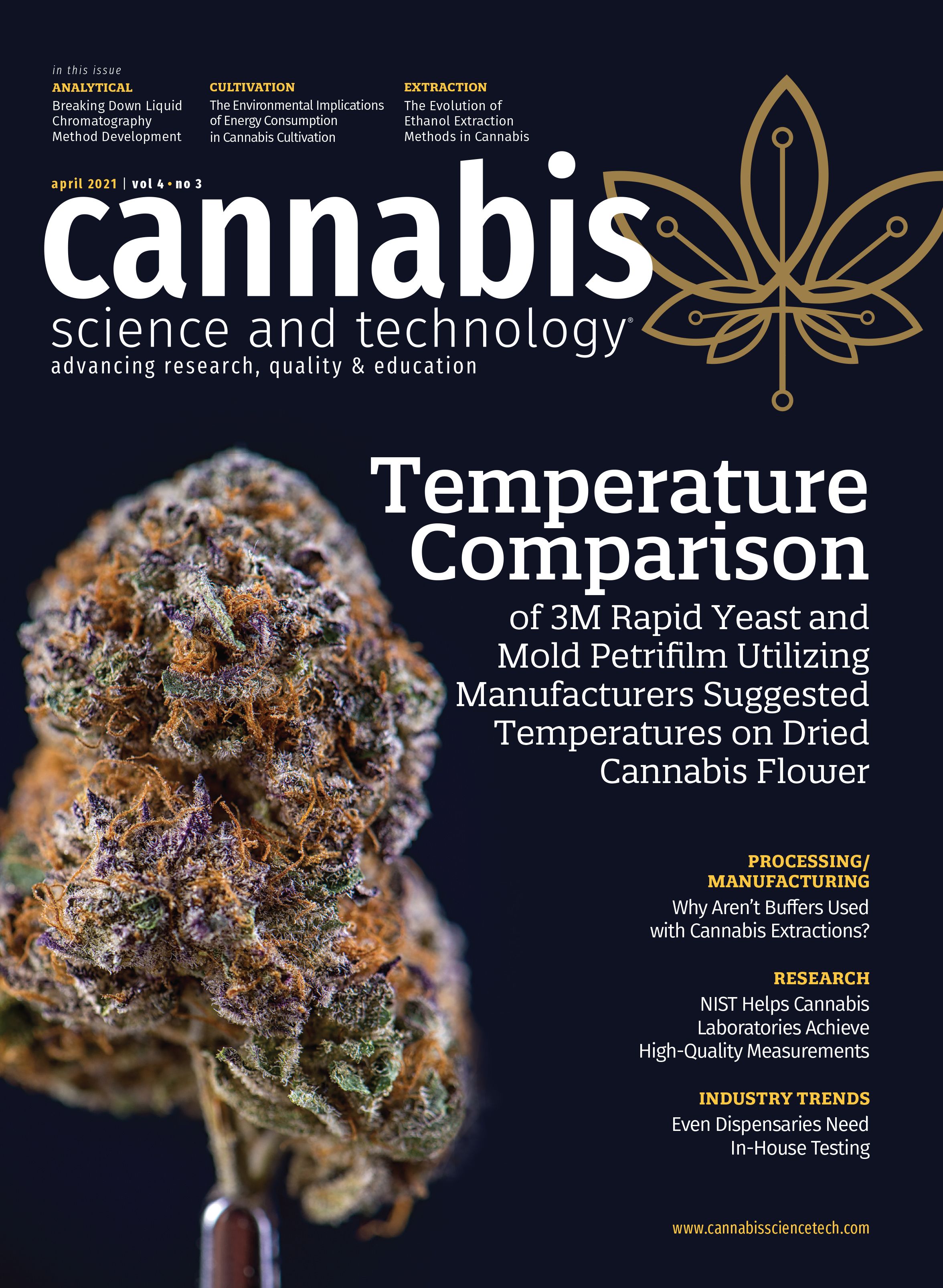Is This Cannabis or Hemp—NIST Helps Cannabis Laboratories Achieve High-Quality Measurements
Dr. Walter Wilson discusses NIST's focus on developing cannabis reference materials and a quality assurance program (CannaQAP).
The National Institute of Standards and Technology (NIST) produces thousands of standard reference materials and has a long history of developing quality assurance programs for improving analytical measurements. Past programs have helped laboratories accurately measure compounds in vitamins, dietary supplements and environmental contaminants. In this month’s “Cannabis Crossroads,” I interview Dr. Walter Wilson, who is coordinating the Chemical Services Division cannabis research program at NIST, with a focus on developing cannabis reference materials and a quality assurance program (CannaQAP). Dr. Wilson is also working on the development of chromatographic methods to separate cannabinoids in complex cannabis matrices such as dried plants, extracts, concentrates, edibles, and so forth. Here, Dr. Wilson shares his progress with us.
It was recently announced that NIST will help laboratories distinguish hemp from cannabis. Can you please tell us more about the study that NIST is inviting laboratories to participate in?
NIST has developed an integrated measurement services program for forensic and cannabis (hemp and marijuana) laboratories to help ensure the quality of routine analysis. The tools developed by this cannabis program will support measurements establishing legal, commerce, and safety claims through the development of fit-for-purpose analytical methodologies, production of fit-for-purpose reference materials (RMs), and implementation of a cannabis quality assurance program (CannaQAP).
CannaQAP was developed to help forensic and cannabis testing laboratories demonstrate and improve measurement comparability and competence. CannaQAP is a perpetual inter-laboratory study mechanism that is similar to a proficiency testing (PT) scheme but without the pass/fail grade. The first exercise of CannaQAP focused on the determination of tetrahydrocannabinol (THC), tetrahydrocannabinolic acid (THCA), total THC, and up to 15 additional cannabinoids in two hemp oil samples. This exercise was completed in November 2020 with 116 participants and the final report will be publicly available soon. The second exercise of CannaQAP is focusing on the determination of cannabinoids, toxic elements, and moisture in multiple cannabis ground plant samples (hemp
and marijuana).
Is this study for cannabis QC laboratories, forensics laboratories, academic laboratories, or everyone? Can you share with us the goals and objectives of this study and exactly how it will work?
The call for sign-ups closed on March 5th with approximately 230 participants, including 22 international laboratories, with the goal of improving the measurement comparability and competence across both the forensic and cannabis communities. Exercise two participants consist of both hemp and marijuana testing laboratories (60%), forensic laboratories (21%), regulators (7%), instrument manufacturers (≈5%), academic laboratories (≈5%), and RM/PT providers (≈2%). We will ship samples to participants in April 2021 and accept results at our CannaQAP website through May 28, 2021. NIST will provide the participants with a preliminary data summary including NIST results in mid-June, which will give participants an opportunity to review and revise their submissions to correct any errors. The final report will be peer-reviewed and made publicly available as a NIST Internal Report (IR), however the identities of individual laboratories are anonymized and known only to them and NIST.
Although the sign-up period has already passed for exercise two, CannaQAP does plan to continue to conduct two exercises a year and include different analytes (such as pesticides and terpenes) and matrices (for example, extracts and edibles) in future studies.
Cannabis QC laboratories are now analyzing 21 or more cannabinoids and many contaminants. Which compounds will be analyzed in this NIST study?
The first exercise of CannaQAP focused on the measurement of up to 17 cannabinoids (see Table I), total THC, and total CBD in two hemp oils, which were selected based on the available commercial standards at the start of exercise one. To keep a link between exercise one and exercise two, the same cannabinoids are being measured in the six different cannabis plant samples. In addition, toxic elements (As, Cd, Pb, Hg, Be, Co, Cr, Mn, Mo, Ni, Se, U, and V), and moisture studies were included in exercise two.

When is the deadline to submit and how long will the study run? Can you point us to a URL or share more details on this project?
The registration for exercise two has already closed. Updates about the CannaQAP are posted on our cannabis website and the CannaQAP website. NIST recommends for any laboratory interested in being a part of future CannaQAP studies, please create an account on the CannaQAP website. There is no charge for participation in the program, but during the account registration process laboratories are required to provide a shipping account number to which future sample shipping costs will be charged.
In July 2021, exercise three sign up will be announced via email to all CannaQAP accounts and sign up will remain open for approximately one month. Participants who wish to receive cannabis samples with total THC mass fraction greater than 0.3% will be required to provide NIST with a Drug Enforcement Administration (DEA) 222 form (domestic) or import permit (international). NIST will ship samples to the participants in October 2021 with testing results due in
November 2021.
How will samples be sent over state lines if this is federally illegal?
NIST has the proper DEA registration to permit the handling of legal hemp or controlled marijuana materials as research samples and transfer of these samples to other DEA registered laboratories. NIST will verify the THC mass fraction of all samples via analytical measurement prior to shipment and provide documentation to ensure all laboratories will receive only materials that they are legally permitted to receive. After consultation with the DEA, NIST requires that all laboratories that wish to receive cannabis samples with THC mass fraction greater than 0.3% must provide NIST with a completed DEA 222 form, which allows for the transfer of control substances between DEA registered laboratories. All submitted DEA forms are reviewed by NIST and DEA for completeness
and accuracy.
There are a wide variety of methods used to determine cannabinoid concentration such as high performance liquid chromatography (HPLC), ultrahigh-pressure liquid chromatography (UHPLC), gas chromatography (GC), mid-infrared (IR) spectroscopy, liquid chromatography-mass spectrometry (LC–MS), and so on. What technologies will be accepted in this study and will data be compared to peer groups (akin to a College of American Pathologists [CAP] survey in clinical laboratories)? What technologies is NIST using in your own laboratories? Is there a “gold standard” technique?
CannaQAP has laboratories use their normal in-house analytical methods to test program samples. NIST also provides a list of several analytical methods currently under development by standards organizations such as ASTM International and AOAC International.
NIST will measure cannabinoids in all CannaQAP samples using liquid chromatography-ulraviolet (LC-UV), LC-tandem mass spectrometry (MS/MS), or GC–MS, which will also be used for assigning mass fraction (%) values to future cannabis reference materials.
NIST is a leader in providing high quality reference standards. Can you tell us more about your efforts to develop hemp reference material? When can we expect to see these reference materials available to laboratories?
NIST has started working on a hemp plant reference material for the determination of cannabinoids, toxic elements, and moisture with a target release date in early 2022. NIST does plan to expand beyond the initial reference material to focus on additional analytes (such as, pesticides and terpenes) and sample matrixes (such as oils, extracts, and edibles). NIST began with plant reference material development to help address the analytical challenges in confidently distinguishing legal hemp from illegal marijuana samples in forensic and cannabis testing laboratories. In both cases, the laboratories need mechanisms to demonstrate competence in making these measurements, which participation in CannaQAP or use of reference materials can provide. The production of reference materials is a lengthy process and we hope that samples provided to participants through CannaQAP can help fill the gap until NIST is able to provide reference materials beyond the initial ground plant material.
Is there anything else that you would like to share about this exciting project?
At the end of 2020, the same cannabis team was awarded a $350,000 grant by the National Institutes of Justice for 2021 for the development of a GC–MS method and evaluation of multiple portable IR spectrometers to evaluate THC content of seized cannabis samples in forensic laboratories. Before the passage of the 2018 Farm Bill, forensic laboratories were only required to confirm the presence of cannabis through microscopic evaluation and GC–MS confirmation of the presence of THC in a seized cannabis sample. Forensic laboratories are now being asked to quantify THC to determine if seized cannabis samples are legal hemp or illegal marijuana, but they do not have the necessary tools to make these measurements. This project focuses on development of these methods at NIST and their transfer into forensic laboratories with standard operating procedures.
CannaQAP can then be used by these laboratories as an analytical test to help them validate these methods and their continued performance.
Will you or your colleagues at NIST be willing to share study results at a future Cannabis Science Conference?
All the results from CannaQAP are published as NIST IRs and will be publicly available through the CannaQAP website. In addition, NIST will be presenting results from these studies at many conferences in the future and would be happy to include the Cannabis Science Conference at some point in the future.
About the Columnist

Josh Crossney is the columnist and editor of “Cannabis Crossroads” and a contributing editor to Cannabis Science and Technology magazine. Crossney is also the president and CEO of Cannabis Science Conference. Direct correspondence to:
Josh@JoshCrossney.com
How to Cite this Article
J. Crossney, Cannabis Science and Technology 4(3), 29-31 (2021).
